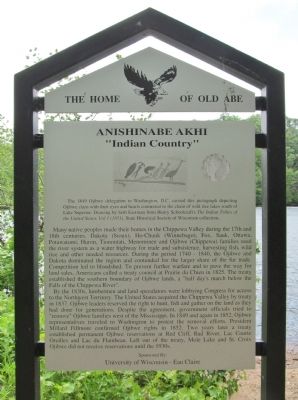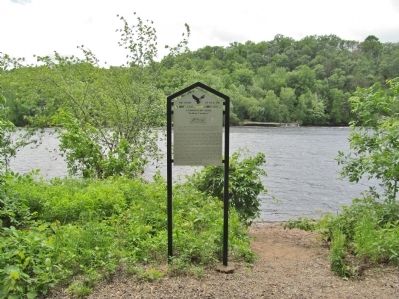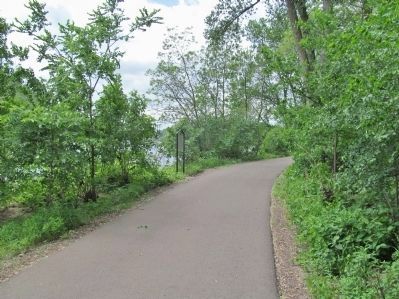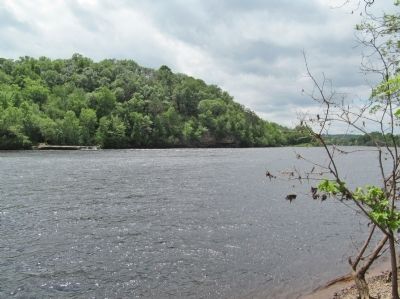Eau Claire in Eau Claire County, Wisconsin — The American Midwest (Great Lakes)
Anishinabe Akhi
"Indian Country"
The 1849 Ojibwe delegation to Washington, D.C. carried this pictograph depicting Ojibwe clans with their eyes and hearts connected to the chain of wild rice lakes south of Lake Superior. Drawing by Seth Eastman from Henry Schoolcraft's The Indian Tribes of the United States, Vol 1 (1851). State Historical Society of Wisconsin collection.
Many native people made their homes in the Chippewa Valley during the 17th and 18th centuries. Dakota (Sioux), Ho-Chunk (Winnebago), Fox, Sauk, Ottawa, Potawatomi, Huron, Tionontati, Menominee and Ojibwe (Chippewa) families used the river system as a water highway for trade and subsistence, harvesting fish, wild rice and other needed resources. During the period 1740 - 1840, the Ojibwe and Dakota dominated the region and contended for the larger share of the fur trade. Competition led to bloodshed. To prevent further warfare and to pave the way for land sales, Americans called a treaty council at Prairie du Chien in 1825. The treaty established the southern boundry of Ojibwe lands, a "half day's march below the Falls of the Chippewa River".
By the 1830s, lumbermen and land speculators were lobbying Congress for access to the Northwest Territory. The United States acquired the Chippewa Valley by treaty in 1837. Ojibwe leaders reserved the right to hunt, fish and gather on the land as they had done for generations. Despite the agreement, government officials tried to "remove" Ojibwe families west of the Mississippi. In 1849 and again in 1852, Ojibwe representatives traveled to Washington to protest the removal efforts. President Millard Fillmore confirmed Ojibwe rights in 1852. Two years later a treaty established permanent Ojibwe reservations at Red Cliff, Bad River, Lac Courte Oreilles and Lac du Flambeau. Left out of the treaty, Mole Lake and St. Croix Ojibwe did not receive reservations until the 1930s.
University of Wisconsin - Eau Claire
Erected by the City of Eau Claire Landmark Commission; University of Wisconsin - Eau Claire. (Marker Number 6.)
Topics and series. This historical marker is listed in these topic lists: Industry & Commerce • Native Americans • Waterways & Vessels. In addition, it is included in the Former U.S. Presidents: #13 Millard Fillmore series list. A significant historical year for this entry is 1849.
Location. 44° 48.035′ N, 91° 30.235′ W. Marker is in Eau Claire, Wisconsin, in Eau Claire County. Marker can be reached from 3rd Avenue south of Water Street, on the left when traveling south. Marker is along the Chippewa River Trail southeast of Owen Park on the University of Wisconsin - Eau Claire campus. Touch for map. Marker is in this post office area: Eau Claire WI 54703, United States of America. Touch for directions.
Other nearby markers. At least 8 other markers are within walking distance of this marker. Owen's Gift to the City (approx. ¼ mile away); First Congregational Church Parsonage (approx. ¼ mile away); Water Street (approx. ¼ mile away); Adin Randall (approx. 0.3 miles away); First Congregational Church / Community House (approx. 0.3 miles away); John Pinkum House (approx. 0.4 miles away); Donald I. "Sarge" Boyd (approx. 0.4 miles away); Katherine and James Wickham House (approx. 0.4 miles away). Touch for a list and map of all markers in Eau Claire.
More about this marker. Regarding "The Home of Old Abe" at the top of the marker – Old Abe, named in honor of President Abraham Lincoln, was an eagle mascot during the Civil War. The eagle accompanied Company C of the 8th Wisconsin Regiment from Eau Claire into every battle and skirmish in which it participated.
Also see . . . Kechewaishke. Wikipedia entry. (Submitted on July 19, 2014.)
Credits. This page was last revised on October 23, 2021. It was originally submitted on July 19, 2014, by Keith L of Wisconsin Rapids, Wisconsin. This page has been viewed 630 times since then and 22 times this year. Photos: 1, 2, 3, 4. submitted on July 19, 2014, by Keith L of Wisconsin Rapids, Wisconsin.



